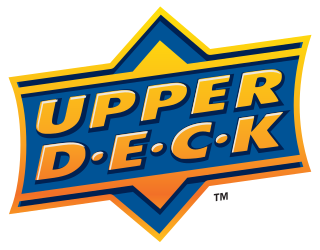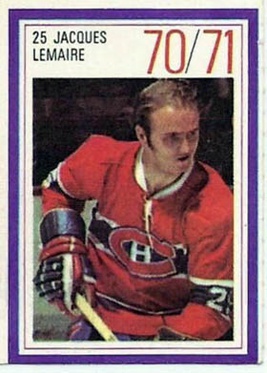The Ted Lindsay Award, formerly known as the Lester B. Pearson Award, is awarded annually to the National Hockey League's most outstanding player in the regular season as judged by the members of the NHL Players' Association. First awarded in 1971, it is a companion to the Hart Memorial Trophy, which is awarded to the League's Most Valuable Player, as judged by members of the Professional Hockey Writers' Association. The award was renamed in 2010 after Ted Lindsay of the Detroit Red Wings.

A trading card is a small card, usually made out of paperboard or thick paper, which usually contains an image of a certain person, place or thing and a short description of the picture, along with other text. There is a wide variation of different types of cards.

A baseball card is a type of trading card relating to baseball, usually printed on cardboard, silk, or plastic. In the 1950s they came with a stick of gum and a limited number of cards. These cards feature one or more baseball players, teams, stadiums, or celebrities.

The Topps Company, Inc. is an American company that manufactures chewing gum, candy, and collectibles. Formerly based in New York City, Topps is best known as a leading producer of American football, baseball, basketball, ice hockey, soccer, and other sports and non-sports themed trading cards. Topps also produces cards under the brand names Allen & Ginter and Bowman.

The Fleer Corporation, founded by Frank H. Fleer in 1885, was the first company to successfully manufacture bubble gum; it remained a family-owned enterprise until 1989.

Donruss was a US-based trading cards manufacturing company founded in 1954 and acquired by the Panini Group in 2009. The company started in the 1950s, producing confectionery, evolved into Donruss and started producing trading cards. During the 1960s and 1970s Donruss produced entertainment-themed cards. Its first sports theme cards were produced in 1965, when it created a series of racing cards sponsored by Hot Rod Magazine.

Alexander Mikhailovich Ovechkin is a Russian professional ice hockey left winger and captain of the Washington Capitals of the National Hockey League (NHL). Nicknamed "Ovi" and "the Great Eight" in reference to his jersey number, Ovechkin is widely regarded as one of the greatest goal scorers of all time. Second only to Wayne Gretzky for all-time goal scoring, Ovechkin also holds many records, including the most power play goals, most goals in away games, and most goals with the same team in NHL history. He is the third NHL player, behind Gordie Howe and Gretzky, to score 800 goals in the regular season.

The Upper Deck Company, LLC, founded in 1988, is a private company primarily known for producing trading cards. Its headquarters are in Carlsbad, California, United States.

In The Game (ITG) was a sports card manufacturing company founded by Brian H. Price in 1998 with its head office in the United States and an office in Canada. The company mainly produced ice hockey trading cards. In 2014 the right to use the "In The Game" name was transferred to Leaf Trading Cards in Dallas, Texas.

The O-Pee-Chee Company, Ltd. was a Canadian confectionery company founded in 1911 that produced candy until the mid-1990s. Based in London, Ontario, the company produced its first trading card sets in the 1930s, releasing several collections of baseball, gridiron football and ice hockey cards until the company was sold to Nestlé in 1996.
The 1954–55 Topps hockey set was Topps' first attempt at producing trading cards for the National Hockey League. At the time, the league consisted of six teams known as the Original Six. Topps included all four American teams in this popular 60-card set - Boston Bruins, Chicago Black Hawks, Detroit Red Wings, and New York Rangers.

A hockey card is a type of trading card typically printed on some sort of card stock, featuring one or more ice hockey players or other hockey-related theme and are typically found in countries such as Canada, the United States, Finland and Sweden where hockey is a popular sport and there are professional leagues. The obverse normally features an image of the subject with identifying information such as name and team. The reverse can feature statistics, biographical information, or as many early cards did, advertising. There is no fixed size or shape of hockey cards, running the gamut from rectangular to circular, however modern North American cards have typically standardized on a 2.5-by-3.5-inch rectangular format.

A rookie card is a trading card that is the first to feature an athlete after that athlete has participated in the highest level of competition within their sport. Collectors may value these first appearances more than subsequent card issues. Athletes are often commemorated on trading cards which are highly collected based on the popularity of the athlete. Prices for rookie cards fluctuate based on consumer interest, supply and demand and other factors, but can surpass thousands of dollars.

The Topps Company has created a number of different baseball card products during its existence. They originally started as a chewing gum company, using the baseball cards as a sales gimmick to make the gum more popular, but today it is primarily a baseball card company.

NHL Power Players was a hockey trading card scheme dreamed up by Imperial Oil and the NHL Players' Association (NHLPA) in the 1970–71 hockey season.

Pro Set was a Dallas-based trading card company founded by Ludwell Denny in 1988. Denny had gained a card license that year after making and selling other NFL memorabilia in previous years. His licensing agreement with NFL Properties allowed Denny to gain access to its extensive photo library and become the first card maker officially associated with a professional sports league. Across the bottom of most of his company's cards was its designation as "The Official NFL Card", a distinction it held through 1991.
Panini is an Italian company that produces books, comics, magazines, stickers, trading cards and other items through its collectibles and publishing subsidiaries. It is headquartered in Modena, Italy, and named after the Panini brothers who founded it in 1961. Panini distributes its own products, and products of third party providers. Panini maintains a Licensing Division to buy and resell licences and provide agency for individuals and newspapers seeking to purchase rights and comic licences. Through Panini Digital the company uses voice-activated software to capture football statistics, which is then sold to agents, teams, media outlets and video game manufactures.

A basketball card is a type of trading card relating to basketball, usually printed on cardboard, silk, or plastic. These cards feature one or more players of the National Basketball Association, National Collegiate Athletic Association, Olympic basketball, Women's National Basketball Association, Women's Professional Basketball League, or some other basketball related theme.















